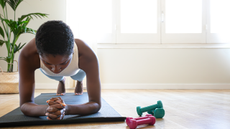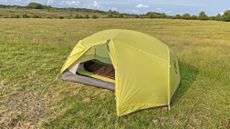Active
The latest Active breaking news, comment, reviews and features from the experts at T3
Explore Active
-

Whoop-rival fitness wearable is finally worth taking seriously thanks to a major new software update
The December update gives Amazfit's Helio Strap a serious upgrade
By Matt Kollat Published
-

A Pilates expert says these 7 standing exercises build core strength, balance and stability
If you struggle with mat Pilates, this low-impact standing routine will be perfect for you
By Bryony Firth-Bernard Published
-

Two dumbbells, five exercises and 24 minutes to add size and strength to your upper body
Here’s an upper body workout you can easily squeeze in around the festive season
By Bryony Firth-Bernard Published
-

Adidas' latest running shoes promise comfort that doesn’t fade, no matter how long the run feels
Runners say the best bit is the end – Adidas’ new Supernova Rise 3 and Glide flip that idea on its head
By Matt Kollat Published
-

Brooks shakes up its lineup with the surprisingly agile Glycerin Flex
The Glycerin goes off-script
By Matt Kollat Published
-

Chris Hemsworth shares a core exercise he’s been doing – and it’s not what you think
It also strengthens the shoulders and hips too
By Bryony Firth-Bernard Published
-

Columbia rebuilt the Battle of Endor with real outdoor gear and it looks incredible
Columbia returns to the forest moon
By Matt Kollat Published
-

Garmin and Strava finally agree on something – 2026 will be the year fitness changes direction
Two giant fitness datasets paint a clearer picture of where movement, motivation and wearable tech are heading in 2026
By Matt Kollat Published
-

Five minutes and this bodyweight workout is all you need to improve your deep core strength
Do this workout three to four times a week for a more resilient body
By Bryony Firth-Bernard Published
-

Arc’teryx resurrects its most surprising pattern and the new collection is wilder than last year’s sell-out drop
Atomic and Arc’teryx expand the camo collaboration that fans couldn’t get enough of
By Matt Kollat Published
-

The top running shoe on Strava in 2025 isn’t the Pegasus, Clifton or Vaporfly – here’s what actually came first
Strava’s new data reveals a shake-up nobody predicted
By Matt Kollat Published
-

Nike just reengineered two of its most important running shoes and the upgrades are far bigger than anyone expected
A stability icon gets superfoam, and a trail legend goes ultra
By Matt Kollat Published
-

Nemo Dagger Osmo 2P Tent review: Wild testing the world’s first fully bluesign-ticked backpacking tent
The new version of Nemo's Dagger Osmo is a lightweight weapon of a tent, with super-sharp eco-friendly creds and cool cutting-edge features
By Pat Kinsella Published
-

People are going crazy over HOKA’s premium slip-ons as shoppers clear sizes faster than the brand can restock
A rugged recovery mule built from suede, neoprene and recycled rubber is suddenly one of the hottest things on HOKA’s site
By Matt Kollat Published
-

Garmin’s newest adventure gadget just made satellite comms feel unexpectedly… familiar
The inReach Mini 3 Plus shrinks big-trip communication into the brand's smallest off-grid device yet
By Matt Kollat Published
-

Adidas revives the Evo SL with an unexpected twist that turns it into a four-season trainer
The new Adizero Evo SL ATR brings Evo-series speed to wet roads and light trails with water-repellent protection and added grip
By Matt Kollat Published
-

Peak Performance just unveiled a jacket that can literally be taken apart and it could change outdoor gear forever
The company's bold new prototype reveals what happens when you design a jacket to be unmade
By Matt Kollat Published
-

John Lewis dropped £132.50 off my favourite Napapijri anorak and now I’ve got a new problem
To buy or not to buy, that is the question
By Matt Kollat Published
-

Forget Cyber Monday – All I want for Christmas is the YETI x Pendleton limited edition wool blanket
If YETI brings it to the UK, I will be first in line
By Matt Kollat Published
-

Cyber Monday’s countdown makes YETI’s final Gear Garage release a now-or-never moment for limited edition gear
The final day of YETI’s once-a-year Gear Garage arrives with a burst of bright orange drinkware
By Matt Kollat Published
-

Olight ArkPro review: a compact no-faff multifunctional flashlight for after-dark adventures
The night is no match for this powerful pocket torch with myriad features and multiple beam options
By Pat Kinsella Published
-

Fjallraven's iconic backpack that can survive being “dragged trodden on and stamped on” is 34% cheaper in Amazon's Cyber Monday sale
The compact Kanken is a superb option for £32 less
By Matt Kollat Published
-

ASICS just made its softest daily trainer even softer – but that’s not the real surprise
The Gel Nimbus 28 enters the scene as a lightweight, max-cushion daily trainer
By Matt Kollat Published
-

I review power stations as a job, and here are my expert picks from Amazon's Cyber Monday sale
From Jackery and Anker Solix to Bluetti and EcoFlow, here are my top picks from this year's sale
By Matt Kollat Published
-

I was at Garmin's Kansas HQ when they launched this watch earlier this year, and now it's cheaper for Cyber Monday
The Forerunner 570 receives its first price cut
By Matt Kollat Published
-

I test fitness trackers – and my favourite affordable tracker just became a steal in the Cyber Monday sale
The Amazfit Bip 6 has Garmin-style features but is less than half the price, and this deal just made it even better
By Bryony Firth-Bernard Published
-

These five-star Beats earbuds that also monitor your heart rate get a five-star discount for Cyber Monday
By Bryony Firth-Bernard Published
-

Forget the Fenix – this is the rugged adventure watch I’m buying this Cyber Monday
The Amazfit T-Rex 3 is packed with similar features, and it’s now cheaper than ever
By Bryony Firth-Bernard Published
-

Fitbit's fan-favourite fitness tracker slides to its lowest ever price in Black Friday’s big rush
Charge 6 is selling for only £88
By Matt Kollat Published
